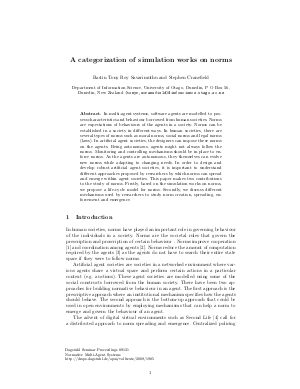A categorization of simulation works on norms
Authors Bastin Tony Roy Savarimuthu, Stephen Cranefield
-
Part of:
Volume:
Dagstuhl Seminar Proceedings, Volume 9121
Part of: Series: Dagstuhl Seminar Proceedings (DagSemProc) - License:
 Creative Commons Attribution 4.0 International license
Creative Commons Attribution 4.0 International license
- Publication Date: 2009-03-11
File

PDF
DagSemProc.09121.3.pdf
- Filesize: 254 kB
- 20 pages
Document Identifiers
Subject Classification
Keywords
- Norms
- creation
- spreading
- enforcement
- emergence
Metrics
- Access Statistics
-
Total Accesses (updated on a weekly basis)
0Document
0Metadata
Abstract
In multi-agent systems, software agents are modelled to possess characteristics and behaviour borrowed from human societies. Norms are expectations of behaviours of the agents in a society. Norms can be established in a society in different ways. In human societies, there are several types of norms such as moral norms, social norms and legal norms (laws). In artificial agent societies, the designers can impose these norms on the agents. Being autonomous, agents might not always follow the norms. Monitoring and controlling mechanisms should be in place to enforce norms. As the agents are autonomous, they themselves can evolve new norms while adapting to changing needs. In order to design and develop robust artificial agent societies, it is important to understand different approaches proposed by researchers by which norms can spread and emerge within agent societies. This paper makes two contributions to the study of norms. Firstly, based on the simulation works on norms, we propose a life-cycle model for norms. Secondly, we discuss different mechanisms used by researchers to study norm creation, spreading, enforcement and emergence.
Cite As Get BibTex
Bastin Tony Roy Savarimuthu and Stephen Cranefield. A categorization of simulation works on norms. In Normative Multi-Agent Systems. Dagstuhl Seminar Proceedings, Volume 9121, pp. 1-20, Schloss Dagstuhl – Leibniz-Zentrum für Informatik (2009)
https://doi.org/10.4230/DagSemProc.09121.3
BibTex
@InProceedings{savarimuthu_et_al:DagSemProc.09121.3,
author = {Savarimuthu, Bastin Tony Roy and Cranefield, Stephen},
title = {{A categorization of simulation works on norms}},
booktitle = {Normative Multi-Agent Systems},
pages = {1--20},
series = {Dagstuhl Seminar Proceedings (DagSemProc)},
ISSN = {1862-4405},
year = {2009},
volume = {9121},
editor = {Guido Boella and Pablo Noriega and Gabriella Pigozzi and Harko Verhagen},
publisher = {Schloss Dagstuhl -- Leibniz-Zentrum f{\"u}r Informatik},
address = {Dagstuhl, Germany},
URL = {https://drops.dagstuhl.de/entities/document/10.4230/DagSemProc.09121.3},
URN = {urn:nbn:de:0030-drops-19057},
doi = {10.4230/DagSemProc.09121.3},
annote = {Keywords: Norms, creation, spreading, enforcement, emergence}
}
